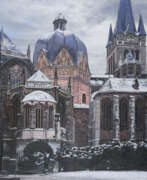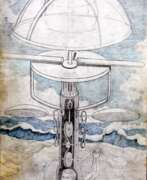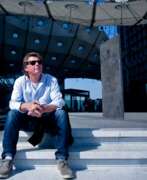Industrial landscape Contemporary art


Friedel Anderson is a German landscape, architectural and object painter.
Friedel Anderson's artistic work encompasses a wide range of techniques and motifs, from landscapes painted against nature, city and harbour views to portraits and still lifes. The landscapes initially focused on the Nordic region. Later, regular journeys through Europe (Italy, France, England) and Africa expanded the themes of his travel and landscape paintings. Anderson found further focal points of his work in shipping, the industrial working world, as well as in the cultural and natural spaces around harbours, rivers and industrial ruins. Interiors and still lifes are also among Anderson's important motifs.


Gennady Fyodorovich Babikov (Russian: Геннадий Фёдорович Бабиков) was a Soviet and Turkmen artist of the twentieth century. He is known as a painter, graphic artist, watercolorist, master of landscape and still life and is considered the founder of the genre of Turkmen industrial landscape, representative of the Russian academic school of painting in Central Asia.
Gennady Babikov participated in the Great Patriotic War, at the front he created more than 100 graphic portraits of fellow soldiers. The artist was famous for his linocuts, and also developed a still life style, which was called "Babikov's" in Turkmenistan.
His works are in many private collections around the world.


Lewis "Duke" Baltz was an American visual artist, photographer, and educator. He was an important figure in the New Topographics movement of the late 1970s. His best known work was monochrome photography of suburban landscapes and industrial parks which highlighted his commentary of void within the "American Dream". His work is focused on searching for beauty in desolation and destruction. Baltz's images describe the architecture of the human landscape: offices, factories and parking lots. His pictures are the reflection of control, power, and influenced by and over human beings. His books and exhibitions, his "topographic work", such as The New Industrial Parks, Nevada, San Quentin Point, Candlestick Point, expose the crisis of technology and define both objectivity and the role of the artist in photographs. He wrote for many journals, and contributed regularly to L'Architecture d'Aujourd'hui. Baltz's work is held in the collections of the Solomon R. Guggenheim Museum, Metropolitan Museum of Art, Tate Modern, Los Angeles County Museum of Art, Whitney Museum of American Art etc.


Bernhard (Bernd) Becher and Hilla Becher were German conceptual artists and photographers working as a collaborative duo. They are best known for their extensive series of photographic images, or typologies, of industrial buildings and structures, often organised in grids. As the founders of what has come to be known as the 'Becher school' or the 'Düsseldorf School' they influenced generations of documentary photographers and artists. They have been awarded the Erasmus Prize and the Hasselblad Award.


Virginia Berresford is an American artist and printmaker.
Virginia Berresford studied with George Bridgman at the Art Students' League and in Paris with Amedee Ozenfan from 1925 to 1930. Berresford was known for her landscape paintings with strong composition and use of colour as well as attention to detail.
In the 1950s she opened an art gallery in Edgartown, Martha's Vineyard. Her work is included in the permanent collections of the Whitney Museum of American Art, the Detroit Art Institute and the Dallas Museum of Art.


Moses Abramovich Blank (Russian: Моисей Абрамович Бланк) was a Ukrainian Soviet artist of the mid-twentieth century. He is known as a painter and graphic artist, distinguished for his still lifes and landscapes.
Moses Blank actively participated in art exhibitions, including national, all-Union and international exhibitions, beginning in 1927. He used various artistic techniques including lithography, etching, ink, watercolor, gouache, pastel, and sometimes oil. During the Great Patriotic War he voluntarily went to the front, after the war he served as an artist in the Air Defense Corps in Riga. The master left a noticeable trace in the history of art in Ukraine.


Edward Burtynsky is a Canadian photographer and artist known for his large format photographs of industrial landscapes. His works depict locations from around the world that represent the increasing development of industrialization and its impacts on nature and the human existence. It is most often connected to the philosophical concept of the sublime, a trait established by the grand scale of the work he creates, though they are equally disturbing in the way they reveal the context of rapid industrialization.


Imogen Cunningham was an American photographer known for her botanical photography, nudes, and industrial landscapes. Cunningham was a member of the California-based Group f/64, known for its dedication to the sharp-focus rendition of simple subjects.


Ken Currie is a Scottish artist and a graduate of Glasgow School of Art (1978-1983). Ken grew up in industrial Glasgow. This has had a significant influence on his early works. In the 1980s Currie produced a series of works that romanticised Red Clydeside depicting heroic Dockworkers, Shop-stewards and urban areas along the River Clyde.


Don Eddy is a contemporary representational painter. He gained recognition in American art around 1970 amid a group of artists that critics and dealers identified as Photorealists or Hyperrealists, based on their work's high degree of verisimilitude and use of photography as a resource material. Eddy has worked in cycles, which treat various imagery from different formal and conceptual viewpoints, moving from detailed, formal images of automobile sections and storefront window displays in the 1970s to perceptually challenging mash-ups of still lifes and figurative/landscapes scenes in the 1980s to mysterious multi-panel paintings in his latter career. Eddy's work has been informed by wide-ranging, sometimes contradictory influences: old masters (e.g., van Eyck and Vermeer), Impressionist and Neo-Impressionist color, the analytical cubism of Braque and Picasso, Hans Hofmann, Conceptual and Minimalist critiques of Abstract Expressionism, and Pop art.


Han Hsiang-ning is a Taiwanese-American artist. Han has participated in many prominent museum exhibitions. He often uses spray painting and paints photo-realistic street scenes. In 1961, he joined the "Fifth Moon Group". He began abstract form oil painting, and his works first appeared in the magazine Pen Review. In 1963 he began working with roller and stencils on rice paper, still abstract, emphasizing form and space structure. In 1969 he began spray painting works using acrylic paint on canvas, created the "Invisible Image" series. In 1971, in the process of spray gun painting, found how to create different combinations of sprayed color dots, a form of pointillism. In 1971 he continued the spray gun technique, but began using New York city-scenes as a subject and his camera as sketching tool. In 1972 he launched studies on industrial scenes with vivid images. He completed his first self-portrait in 1981. In 1983 he began using brushes to paint watercolor and ink on paper. His subjects being street crowds and bird's eye views of intersections of New York streets.


Hipkiss is the pseudonym of Alpha and Christopher Mason, both artists born in 1964 in Britain.
The artists began working together in the UK, then moved to France, where they continue to live and work. They are known for detailed, detailed figurative drawings created in a mixed media technique that combines pencil, silver ink and metallic foil. The artists draw large-scale urban landscapes, landscapes, strange insects, plants and birds, depicting images of a utopian future where nature has conquered the industrial environment.


Alfred Kornberger was an Austrian painter and graphic artist. He studied painting with Professor Robin Christian Andersen at the Academy of Fine Arts in Vienna.
Stylistically, he dealt with the different facets of classical modernism and was inspired by Pablo Picasso's late work as well as by the depictions of surrealist artists. In his early years he devoted himself to various themes from the world of industry as well as topographical depictions. Later he turned almost exclusively to the depiction of the female nude.
Alfred Kornberger's work is part of the great Austrian tradition of body-oriented art, which ranges from Egon Schiele to Alfred Hrdlicka. His central theme, the female nude, is not only a projection of sensual desire but also an expression of psychological states.


Valerii Nikolaevich Koshliakov (Russian: Валерий Николаевич Кошляков) is a Russian painter, graphic artist, author of installations, lives and works in Germany, France and Moscow.
He studied at the Rostov Grekov Art School. Koshliakov works mainly with images of architecture, which in his works appears as a memory of the former greatness. The artist uses canvas, paper, kraft, but most often cardboard, pieces of which make up huge canvases and entire installations. On this basis with diluted colors he creates a very light, yet monumental painting, which imbues the material with a web of sweat, reflecting the author's unique vision.
The works of this successful artist are in the collections of the world's major museums, including the Tretyakov Gallery, the Guggenheim Museums in New York and Bilbao.


Wilfrid Moser was a Swiss abstractionist painter, sculptor, and printmaker. A multifaceted artist, he worked in a variety of techniques and created entire cycles of works on subway stations, bridges, city streets, houses and shops. Colorful woodcuts, sculpture, stained glass and even cave landscapes are all the legacy of a talented artist.


Luigi Rocca is an Italian hyperrealist painter.
Luigi was born into a family of artists and, influenced from a young age by his grandfather's photographic work, he eventually became one of the leading exponents of photorealism.
He made repeated exploratory trips to New York City, a city full of architecture, advertising and light, which inspired him to create magnificent photorealist motifs. Rocca combined his classical technique with modern realism, creating illusionistic and richly detailed paintings that are recognized by art lovers and collectors around the world. They appear so realistic that it's hard to see the difference between a photograph and a painting.


Mikhail Petrovich Staniouta (Russian: Михаил Петрович Станюта) was a Belarusian Soviet artist. He is known as a painter, graphic artist and teacher.
Mikhail Staniouta worked mainly in easel painting in the genres of thematic painting, portrait, landscape, still life. His narrative and thematic paintings were distinguished by their topicality, expressiveness of composition and drawing, color saturation. The artist also worked in graphics, which in his creative heritage is represented, in particular, by sketches of self-portraits of the master.


Nichole Velasquez is an American photographic artist.
He explores the detachment of color and form from their descriptive functions on analog film. His goal is to allow the emotional experience to take center stage in interpreting the work. Velázquez works with analog film, exploring emotional memories through the technique of multiple exposures. He worked with material scientists at the Technical University of Berlin to create silver plates, using mirrors as mediators for human color perception.


Martin Ziegelmüller is a Swiss painter, draughtsman, printmaker, and printmaker. Ziegelmüller's current oeuvre includes thousands of works, mainly oil paintings, but also watercolors and prints. A passion for color and light moods and a close relationship to nature underlie his work. The artist's favorite subjects are water landscapes, urban and industrial panoramas.

















































